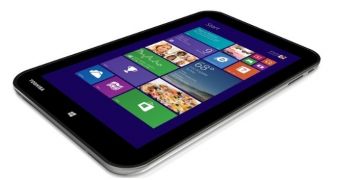If you’re looking to purchase one of the cheaper Windows 8 tablets that come with 32GB of internal storage, you might want to take a minute and browse through this article before heading out to the store or clicking the “Buy” button online.
Currently, there are a lot of Windows 8-based tablets that run Intel Bay Trail Atom processor and come with a free copy of Microsoft Office Home and Student 2013. Examples include the ASUS Transformer Book T100, Dell Venue 8 Pro, Acer W4 and so on.
These offerings come with varying screen sizes ranging from 8-inch to 10-inch. And when pricing is concerned, these products are a great bargain. Customers who are lucky enough can even get them even for $250 / €182 if they are on discount.
Nevertheless, devices coming with sub $300 / €219 price-tags also offer 32GB of internal storage, and those opting for the 64GB version would have to pay at least $50 / €37 extra.
Even so, you might want to consider throwing in an extra buck and getting the more spacious version. The reason is pretty simple. Windows 8 plus Office, Windows Recovery partition and the additional bloatware usually takes up half the space the tablet comes with.
So basically, you’ll be left with only 15GB of free space, where you can install whatever you need. Even if most tablets come with microSD, thus giving users the possibility of expanding, there are still limitations to this way of doing things.
For starters, users can’t install Metro-style apps on the SD card. Game apps like Grand Theft Auto San Andreas (downloadable from the Windows Store) will swiftly take up a massive 2.5GB of internal storage in one shot.
Add to that a few more games and your tablet won’t be able to breathe anymore. Of course, workaround for installing Metro apps on external storage devices can be found, but some users might not want to take the hassle upon themselves.
Keeping things simple is an important aspect for many users when it comes to tablet usage. That’s why many tableters don’t want to bother setting their default locations of Libraries (including Documents, Downloads, Pictures and Videos) to the microSD card.
If you don’t do this, importing let’s say an 8GB SD card from your camera in the Picture folder will result in the free storage on your Windows 8 tablet being halved.
So, going for a 64GB Windows 8 tablet instead makes things a lot more easier, something that completely justifies the higher price tag.

 14 DAY TRIAL //
14 DAY TRIAL //